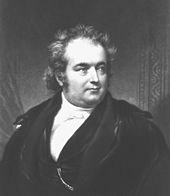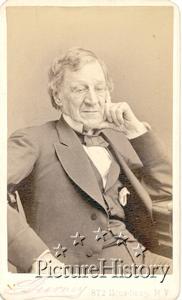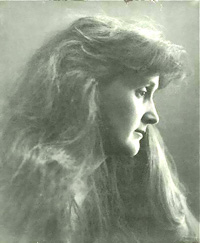|
|
|
 |
When a Famous Scientist Discovered Spirits
Posted on 21 October 2013, 9:07
When Professor James Mapes, (below) a renowned inventor and analytical chemist, first heard about the phenomena of spiritualism, he thought it was so much bunk. He was a man of science and could only scoff and sneer at the stories he was hearing about spirits communicating and producing various phenomena. However, when, sometime during 1852, his wife and daughter began displaying mediumistic abilities, he was forced to investigate and reconsider.

Mapes’s wife, who had no apparent prior artistic ability, suddenly became a painting medium, producing art of the highest quality, while his daughter became an automatic writing medium. One day, his daughter claimed to be receiving a message from Mapes’s father. When Mapes asked for proof of identity, the daughter’s hand wrote, “You may recollect that I gave you, among other books, an encylopaedia. Look on page 120 of that book, and you will find my name written there, which you have never seen.” Mapes went to the warehouse where the books were stored, opened the crate, which had been unopened in 27 years, and found his father’s name written on page 120.
It was then time for Mapes, who is credited with inventions that revolutionized agriculture, to do a serious investigation. He sat with D. D. Home and witnessed physical phenomena that defied scientific laws. He began attending various mediumistic circles but observed nothing to convince him that spirits were involved until on one occasion he received a message about something known only to himself and the spirit communicator. He asked the spirit communicator how he could satisfy himself as to the truth of it all and was told to form a circle of 12 individuals, six positive and six negative, and to find the best medium he could, then to continue the sittings until he received something he could accept. Mapes asked for clarification relative to the positive and negative minds. He was then informed that the positive minds were those who thought independently, unconcerned with what others thought, while a negative mind was one who relies on his or her friends before making a decision.. “Both these classes of minds are necessary for an effective circle,” the communication came. “When you have met twenty nights, you will have no further difficulty in inducing your friends to continue their sittings.” He was further told that the positive minds should be non-believers.
Mapes had no difficulty finding the negative minds, but had a hard time persuading his non-believer friends to participate for 20 nights. “For the first eighteen nights, both questions and answers were extremely stupid,” Mapes recorded. “The only curious phenomenon was the raps, and with all the theories of snapping of toe and knee joints, rubbing the ball of the foot on the sole of the boot, electricity, and all the other theories which had been from time to time advanced, the six positive minds were divided; but with negatives it was affirmed that there was a marvelous fitness in many of the replies, although the positive minds would not admit it.”
On the 19th night, when the positives expressed relief that their commitment was nearing an end, names of deceased relatives and friends began coming through for the positives with pertinent questions and answers given. On the 20th night, they experienced physical phenomena, including a guitar and a harmonica playing with no hands holding them. “The room was well lighted with gas, and the hands of the circle were placed on the top of the table,” Mapes noted.
“Even the positive members agreed to continue their sittings and the same circle sat for more than four years, once each week.” They received much more dynamic manifestations during those four years.
In 1854, Mapes traveled to Buffalo, New York to observe and study the mediumship of 14-year-old Cora L. V. Scott (later Cora L. V. Richmond) . Beginning in 1851, at age 11, young Cora (below) would go into a trance and lecture on subjects far beyond her education, experience, and exposure. The subjects of her lectures included social, political, economic, and religious matters, even extending to the emancipation of slaves. Large crowds gathered to hear her lectures and word soon spread of this amazing girl. In addition to subjects selected by her spirit guides, Cora (or her guides) invited questions or subjects from the audience. Mapes asked her to speak on “primary rocks,” to which she (or the spirits) replied with a discourse on geology that left Mapes awestruck. “I am a college educated man, and have been all my long life an investigator of scientific subjects and associated with scientific men,” he reacted, “but I stand here this afternoon dumb before this young girl..”

In a later writing, Mapes stated: “She renders the most abstruse points perfectly understandable to the most common auditor. In close analysis of words she is not surpassed, and her knowledge of natural law seems to be an intuition amounting to almost a certainty. Her high-toned moral character has at all times defied the tongue of calumny. In metaphysics she shows a degree of erudition hitherto amongst the greatest scholars of the world.”
Mapes summed up his observations by writing: “The manifestations which are pertinent to the ends required are so conclusive in their character as to establish in my mind certain cardinal points. These are:
“First, that there is a future state of existence, which is but a continuation of our present state of being, devoid of such portions of our organism as are now denominated material.
“Second, that the great aim of nature, as shown through a great variety of spiritual existences, is progression, extending beyond the limits of this mundane sphere.
“Third, that spirits can and do communicate with mortals, and in all cases evince a desire to elevate and advance those they commune with.
“Fourth, that spirits have, in a vast number of well-attested instances, proved their will and ability to ward off dangers, cure sickness, prevent crimes, reform criminals, restore lost property, and communicate many useful, scientific, and some highly-occult and novel ideas to mankind.”
Michael Tymn is the author of The Afterlife Revealed: What Happens After We Die is published by White Crow Books. His latest book, Resurrecting Leonora Piper: How Science Discovered the Afterlife is now available on Amazon and other online book stores.
Paperback Kindle
Next blog post: November 4
Read comments or post one of your own
|
 |
Debunking Babe Ruth & Leonora Piper
Posted on 07 October 2013, 11:58
Babe Ruth is considered one of the all-time greats of baseball, if not the greatest player ever. His 60 home runs in a single 154-game season (1927) has yet to be surpassed by anyone not suspected of using performance-aiding drugs (Roger Maris hit 61 home runs in a 162-game season.). However, to a person not knowing much about baseball, I could, by using the tactics employed by debunkers in writing biographies of famous mediums for popular Internet encyclopedia sites, make a case for Ruth being a very poor ballplayer. To begin with, I would simply focus on his last year, when he was 40 years old, and just a shell of his old self. He had lost much of his power and agility by that time, and his batting average and other numbers weren’t close to what they had been during his peak years 5-10 years earlier.
.
But even during his peak years, Ruth,, like the best of hitters, failed roughly two out of every three times he came to bat. More average players fail three out of every four at bats. And as for hitting home runs, Ruth failed 11 out of every 12 times at bat, which is an outstanding failure rate. Considering swings at the ball rather than at-bats, he failed much more often, probably 29 out of every 30 swings. If I were to reason like the debunkers do on mediums, I would dwell on the fact that Ruth struck out 1,330 times during his career and not even mention one of the 714 home runs he hit. I would especially focus on the important games in which Ruth failed to deliver and I would avoid mentioning his many game-winning hits. A person who knew nothing about Ruth or about baseball might read my encyclopedic biography of him and believe that Ruth was a complete flop as a baseball player rather than a Hall of Fame great.
It would be a very unfair and biased treatment of a great ballplayer, but that is the very way some of the major Internet encyclopedias offer the biographies of great mediums. For example, my book about Leonora Piper, one of the renowned mediums of yesterday – one whose ability was attested to by a number of esteemed scientists and scholars of the day – includes hundreds of “hits” and dozens of “home runs,” but you won’t find any one of them mentioned in the entry on her at one popular Internet encyclopedia. Only her “strike-outs” are mentioned, and the reader is left to assume that she was nothing but a charlatan.
Mediums are a lot like baseball players – and every other type of skilled person, athletic or not – in that they get “hits” and “misses.” They succeed at times and fail at other times. Just as a baseball player must “read” the pitch coming to him – fastball, off-speed, breaking ball, slider, etc.—if he is to make perfect contact with the ball, mediums must “read” the symbols and pictographs they see in their mind’s eye if they are to be judged successful. There are those times when they “hit the ball out of the park” with information that is accurate beyond doubt and so private and personal that there is no way it could have been researched or known to the medium. There are also times when they “strike out” by misinterpreting what they see. One “hit” in every three statements made by the medium would seemingly be a pretty good average and far above chance guessing.
But the debunkers and pseudoskeptics, not understanding the dynamics of mediumship, assume that a medium must be 100-percent accurate if he or she is to be judged legitimate, and since no medium on record has ever been 100 percent accurate, it follows, for them, that they must all be frauds. It is scientific fundamentalism in the extreme. They fail to comprehend the fact that there are many obstacles to clear communication between the realms of the so-called “dead” and the living.
Beginning in 1851, Judge John Edmonds, (below) Chief Justice of the New York Supreme Court, spent 23 months investigating mediums, witnessing several hundred manifestations in various forms and keeping detailed records of them. “There are false communications which are not intentionally so,” Edmonds explained, “some arising from a mistake of the spirit who is communicating, and some from the error of the medium who has not yet so studied himself as to be able to distinguish the innate action of his own mind from the impress of spirit influence.” Edmonds went on to say that “sometimes timidity and diffidence will color and sometimes vanity and fanaticism distort the teachings of the spirits.”

The spirits who communicated, Edmonds pointed out, were not on equal footing. They varied significantly in advancement. “Some are more, and some less, ignorant than others; some more prudent and careful; some more zealous and inconsiderate; some impulsive and rapid, and some calm and deliberate; in fine, with every conceivable variety of attribute and faculty. Of necessity, the communication from each of these must be affected, as all human intercourse is, by the peculiar characteristics of each individual.” In effect, Edmonds stressed, those receiving the messages must discern the messages.
Robert Hare, a distinguished professor of chemistry at the University of Pennsylvania, began as a debunker before hearing from his deceased father through a medium. “As there are no words in the human language in which spiritual ideas may be embodied so as to convey their literal and exact signification, we are obliged oftimes to have recourse to the use of analogisms and metaphorical modes of expression,” Hare was told by his discarnate father. “In our communication with you we have to comply with the peculiar structure and rules of your language; but the genius of our language is such that we can impart more ideas to each other in a single word than you can possibly convey in a hundred.”
Numerous other distinguished researchers since Edmonds and Hare have come to understand the barriers to spirit communication, but mainstream science, in all of its arrogance and obstinacy, has not understood. No doubt there are many of them who understand baseball, but they won’t open their minds enough to see the similarities.
So many of the errors in spirit communication result from misinterpretations by the mediums, or in the case of trance mediums, by the medium’s spirit control. That is because much of it is pictographic, the control or the medium must interpret what the image is intended to portray. When the medium struggles to interpret, the debunkers see this as “fishing” or “cold reading” and cry fraud. .
In physical mediumship, materializations are usually imperfect or very partial, because either the medium is not powerful enough to produce the required ectoplasm or because the spirit trying to materialize lacks the ability to project his/her image into the ectoplasm. But the debunkers scoff in self-righteous indignation and point to how ridiculous it all is.
Baseball players and other athletes have found that when they are “in the groove,” or “in the zone,” they perform much better. Baseball players say they are able to “see” the ball much better when they are in this zone, sort of a heightened state of awareness. When they are not in that state, they struggle and go into slumps. Likewise, with mediums. Most of them require a passive state, one requiring a certain harmony and peace of mind. Mrs. Piper, (beow) for example, would often fall into a trance state within a minute or two, but there were times when it took much longer or she could not achieve the trance state at all because of illness or too much anxiety. Other mediums have required singing and prayers for a half hour or more before achieving the proper passive state. When trance mediums do not achieve the full trance state, their own subconscious minds apparently enter into the communications and garble things quite a bit. The parapsychologists then write it all off as subconscious phenomena, while the debunkers again cry fraud.

Baseball players come in varying degrees of skill and ability, and so also do mediums. There have been very few ballplayers in the Babe Ruth category, and likewise there have been very few mediums like Leonora Piper . Some mediums are equivalent to minor league baseball players and will never make the “majors.” And while many people can play baseball, very few are good enough to play professionally at any level. So it is with mediumistic ability.
And like ballplayers, mediums, too, tend to decline after so many years of effective mediumship. Sometimes they lose their ability completely. The debunker will focus on those declining years, as they have with Mrs. Piper, and call it all bunk.
Some debunkers say that we don’t have mediums today like Leonora Piper because they were all frauds and it is not so easy for these frauds to trick people these days. It has been 86 years since Babe Ruth set his record of 60 home runs in a 154-game season. Since nobody has broken it, does that suggest that Ruth was a fraud of some kind?
The scientific fundamentalists just don’t understand it all, and, unfortunately, the people who manage those encyclopedia sites appear just as ignorant and closed-minded. Is it any wonder that the general public is confused?
Michael Tymn is the author of The Afterlife Revealed: What Happens After We Die is published by White Crow Books. His latest book, Resurrecting Leonora Piper: How Science Discovered the Afterlife is now available on Amazon and other online book stores.
Paperback Kindle
Next blog post: Oct. 21
Read comments or post one of your own
|
|
|
|